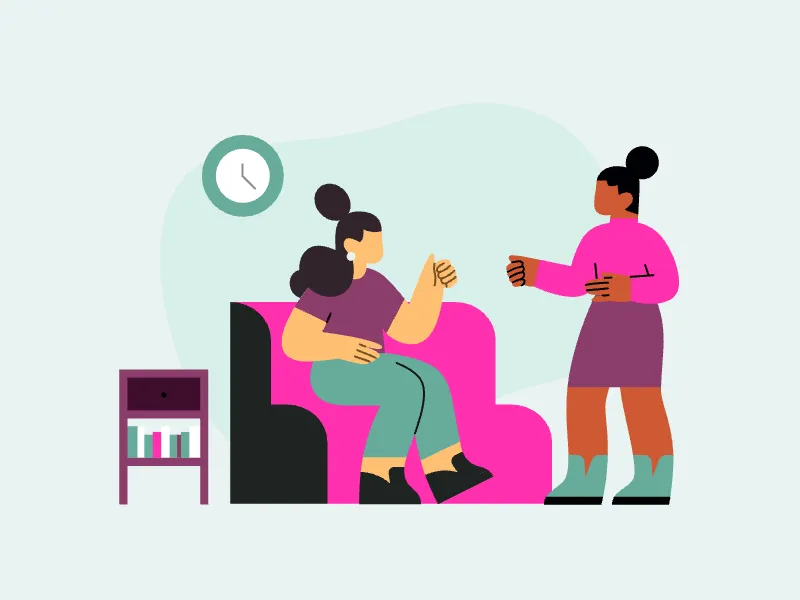Understanding children with eating disorders
Eating disorders are most often associated with adolescent children and young adults. Studies show that: (1)
- Of those identifying as female, between 0.3-0.4% will meet the diagnostic criteria for anorexia nervosa at some point in their lifetime.
- Approximately 3.5% of those identifying as female and 2.0% of those identifying as male have had binge eating disorder during their life.
- Of those identifying as female, nearly 1.0% will meet the diagnostic criteria for bulimia nervosa at some point in their life, while approximately 0.1% of those identifying as male will also meet these criteria.
- Studies have found links to binge eating disorder (BED) and atypical anorexia can appear in early childhood, in kids as young as five years old. (8)
However many don't realize that young children can be significantly affected by the medical, nutritional, psychological and social consequences of each of the eating disorders outlined in the Diagnostic and Statistical Manual of Mental Disorders (DSM–5).
Stats & trends in children with eating disorders
Eating disorders can be incredibly difficult to spot in children, especially under the age of 13. Research shows that higher rates of eating disorders are being seen in younger children (12 and under). (2)
There are several emerging reasons as to why more children are struggling with eating disorders, including neurobiological and genetic predispositions. For example, suppose a mother has struggled with malnutrition and/or eating disorders in their lifetime. In that case, research shows that their children are at an increased risk for modeling their parent’s behaviors and adopting their relationships to food. (1,3)
The idealization of thinness and weight stigma are other significant factors in children falling into eating disorders at younger and younger ages. Research has shown that an estimated 40-60% of elementary school girls (ages 6-12) are concerned about their weight and are fearful of becoming "fat.” (4) And teen girls aren’t the only ones who feel the pressure exerted by sociocultural influences—adolescent boys are also affected by the idealized version of the male body portrayed by popular culture (e.g., movies, TV, and action figures) and the media.
This body image ideal typically involves a muscular build that many teen boys attempt to pursue. As such, eating disorders may present differently in boys, who are focused on muscularity as opposed to thinness. (10)
The shame around weight and eating can start from a young age, and may even begin at home. Pressure to be skinny doesn’t only come from their peers, as approximately 40% of overweight females and 37% of overweight males are teased about their weight by their family members. (5)
In fact, a study completed in 2009 found that any emphasis placed on weight in children, particularly measures used to enhance “weight loss” by parents or peers actually ended up causing children to gain weight, and develop body image issues making them more susceptible to developing disordered eating behaviors. (9)
{{link-bank-two-column}}
Child eating disorder signs & symptoms
In children with eating disorders, you may not always be able to identify physical signs of disordered eating because a child’s weight is constantly changing as they grow. However, it may be more likely that you notice changes in eating patterns or food preferences, as well as emotional or behavioral changes in your child. It is normal for a child to gain weight at various times in their development, especially in prepubescent children, which can sometimes trigger a drive toward dieting and weight loss, when the child (or family member or even doctor) becomes alarmed about such changes
It can be helpful to know what to look for and who to turn to for help. Below are some of the common signs and symptoms of eating disorders in children.
Fear of eating
Eating disorders create a lot of fear in children, leading to the development of food fears or phobias (fear of eating a particular food, or fear of being seen eating it), and discomfort with eating in general.
Due to these fears, a child can easily fall into an Avoidant Restrictive Food Intake Disorder (ARFID). Children with ARFID may have a fear of choking, and may avoid certain foods due to their smell, taste, or texture. (6) ARFID traditionally has three main causes: psychological, genetic, and sociocultural. Children may have had a shocking experience related to eating, or a general lack of pleasure in eating and/or sensorimotor issues related to taste, texture, or smell, which can also co-occur with other developmental issues.
Distorted body image
Another sign that a child may have an eating disorder is that, even as a young child, they struggle with body positivity. Your child may begin to notice that a child becomes concerned about their body size and shape, or begins to compare themselves with their peers. The natural distribution of body size, type height and shape can be overwhelming for a child, especially when these fears are reinforced by our fatphobic culture. Children with eating disorders may begin to feel inordinately dissatisfied with their bodies and shape as they get older based on a constellation of variables, leading to restriction and all of the complex neurobiological and psychological ramifications.
Fluctuations in weight
Children who start to experience large fluctuations in their weight (both gaining and losing) may be struggling with an eating disorder. This can closely tie to body image issues, as puberty can create vast changes in your child, and their self-image.
Isolation
If a child starts to express negative emotions about their appearance, and they begin to isolate themselves, or demonstrate fear or rigidity in their relationship with food, it could be linked to disordered eating. Kids with eating disorders may become extremely withdrawn and may be unable to focus on the things they love, and on the other hand, they can remain high functioning and have their pain and suffering go unnoticed.
Irritability/mood swings
Children who have eating disorders will often experience mood changes, including extreme irritability and emotional outbursts.7 They may also begin to engage in odd or unexpected behaviors that are not typically a part of their personality.
Problems with excessively dry skin
Looking at your child's skin can often be an indicator of trouble. Children with eating disorders may have incredibly dry, flaky, or scaly skin, which results from their body's not getting enough nutrients.
Problems with their teeth
Children with eating disorders are at risk for significant malnutrition, which can result in erosion and cavities in their teeth. If they are suffering from purging behaviors, they may also erode or yellow the teeth, and may even be prematurely losing them.
Excessive/unexplained fatigue
Many children with eating disorders suffer from chronic fatigue and lack of energy and poor concentration. As a result, they tend to be exhausted and may not be able to focus on their studies or complete normal tasks or even engage in pleasurable activities and more typical childhood activities.
Osteopenia and osteoporosis
These are two of the irreversible manifestations of eating disorders that present in both kids and adolescents. Osteopenia occurs when the bones do not get enough nutrition, which is why it’s an ever-present risk for children and adolescents who engage in disordered eating practices. Osteopenia can cause improper bone growth, and can lead to osteoporosis, an incurable bone disease.
Treatment programs for children with eating disorders
If you notice any of the signs or symptoms of an eating disorder, it is important to take your child to their doctor immediately. Without medical intervention, your child could be experiencing life-threatening malnutrition and other complications.
There are several types of treatment programs you can seek out in order to help your child, though the most common treatment option is usually a combination of therapies, including: (2)
Family-based treatment (FBT)
A type of therapy that focuses on educating the entire family about the disorder and teaching them how to support their child so they can heal. FBT offers a systematic intervention that empowers the family to become an ally of the patient in overcoming the eating disorder and especially focuses on the parents intervening and interrupting the eating disorder behavior (putting boundaries around the eating disorder).
FBT can be especially healing for some patients, however in other situations it can be very complicated. If a family is not available to provide this type of meal-by-meal oversight, and/or if there are other behaviors such as purging, over-exercise or other forms of self-injury, this may pose a challenge. Additionally there may be many reasons why utilizing the family to oversee food can escalate conflict and interrupt in a therapeutic and healing process. Each individual circumstance is unique.
In general, when working with children who are younger, it may be more advantageous to utilize this method and/or find interventions that would allow the child to remain with family.
Cognitive Behavioral Therapy (CBT)
CBT is a type of talking therapy that focuses on developing an ability to recognize thoughts that are eating disorder related and new, objective reality so that your child can learn to better manage thoughts, emotions and behaviors.
DBT
DBT focuses on building a set of skills that can aid patients in eating disorder recovery. Your child will learn and cultivate a mindfulness practice, as well as build and improve upon emotional regulation, distress tolerance, and interpersonal effectiveness skills.
Exposure therapy
Exposure therapy, which is a subset of CBT, helps to treat symptoms of anxiety that often accompany eating disorders. Many eating disorder patients experience a profound sense of anxiety related to eating patterns and body image that can cause them to be avoidant. For example, they may avoid a certain food group, due to a cognitive distortion they may have formed related to that food. Exposure therapy exposes patients to their fear in a controlled, caring environment, which over time, can lead to a reduction in anxiety.
Group therapy
Group therapy may include several treatment modalities, such as DBT groups, CBT groups, and Acceptance and Commitment Therapy (ACT) groups. Group therapy can be highly beneficial for your child in a number of ways, including cultivating connections, sharing meals with others, encouraging open and honest sharing, and experiencing acceptance.
Nutritional counseling
When your child is suffering from malnutrition or an eating disorder, it can be critical to work with a dietitian that is skilled in the management of eating disorders. Having a good nutrition plan in place can prevent the worsening of their existing symptoms and help them address symptoms, and be supported in meeting their nutritional needs.
Helping children cope with eating disorders
If you have a child struggling with an eating disorder, it's crucial that you know how to help your child express their inner struggles, get support, and ultimately heal. Below are some tips to help you do just that:
Provide a safe & comfortable environment
Creating a safe and structured environment for your child to heal is a very powerful first step. A comfortable, peaceful space where they can feel nurtured and be themselves can help move the healing process forward.
Spend time with them
Your child may be self-conscious and uncomfortable, and if they weren't already at odds with themselves, they may feel extra self-conscious around you. Helping them be themselves, and communicate authentically can be a significant part of the healing process. Spending time with them and talking with them about other aspects of their lives, or how you can be supportive in the moment, may be topics worthy of discussion. Time together can become more and more meaningful and help them take the first step toward healing.
Don't focus on food and exercise outside mealtime and therapy
It may be worth considering whether it is advisable to discuss food and exercise with your child outside of mealtime and therapy sessions. If your primary focus is on their food intake or control of movement, it can lead to more insecurity and frustration, which may confuse your child and strain your relationship. There are therapists and also parent coaches who are familiar with the healing process in families impacted by eating disorders, who can be very helpful in navigating this terrain.
Celebrate their triumphs
When your child shows signs of healing, let them know that you will stay by their side and strive to remain close to them for the duration of healing from their eating disorder and beyond. Even the smallest moments of healing steps are a big deal and can be celebrated as such to help your child feel more confident and better about their healing process and their pathway, over time, each and every day.
How to parent a child with an eating disorder
Supporting your child at home
Any interventions as a parent should be centered around health, and not your child’s weight. As a parent, it is important to create safe spaces for your child to move their bodies, without the focus being on weight loss or weight concerns. For example, embracing the joy of healthy movement in early childhood through sports, walking, biking, gardening, or other hobbies or activities is a helpful way of doing this.
It is recommended you avoid any eating or exercising mandates built into “weight loss” for your child, as these practices only expose them to body image issues at a young age.
Putting energy into outdoor activities, genuine “play” (without an agenda) and boundaries around screen time, all can have a positive impact on mental and physical happiness and health as well.
Avoid using outdated terms like obesity and “normal weight” when speaking with your child about body shape and size. There is no “normal weight” as this is based in outdated body mass index (BMI) practices that reduce health to a number on a scale, without taking into account broader psychological, social, and biological factors. Instead, parents and physicians could use an individual growth chart that tracks growth over time, at the individual level, instead of against a “normal weight.” This measurement should be done in a private setting, free from any comments.
As a parent, it’s also important to be a positive role model for your child. This doesn’t mean that you have to be perfect or that you can’t struggle with body image issues yourself, but it does mean that you should be mindful of what you say and how you behave when your child is around. This includes how you talk about yourself and others, too. Make it a point to avoid all shaming, stigmatizing, or negative comments related to the physical appearance of others, whether they are people in your family, friends, strangers, celebrities, or professional athletes.
You may also want to introduce mindful eating into your home. This practice is exactly as it sounds—during mealtimes, you and your family practice being present and acknowledging each of your senses when consuming a meal. Put away your phones, turn off the TV, and be present with each other. Another common facet of mindful eating is that of expressing gratitude for where your food came from and those who made that possible. Mindful eating can help to reframe mealtimes for your child, who may feel distress or avoidance surrounding them. Plus, this practice will likely benefit the whole family and your relationships.
Supporting your child at school
You can be an advocate for your child at school where many of the disordered eating behaviors can develop due to pressure from peers or even teachers. Educating parents, peers, and teachers about how they talk about weight and body image will also go a long way in supporting your child while they are in their school environment. Arranging to have an educator talk about diversity training and size bias is a good way to get everyone involved.
Address any bullying or teasing directly with the school to prevent it from being an ongoing issue.
Other school stressors that may trigger disordered eating symptoms in your child include the pressures related to academic performance. Make sure your child knows that their worth is not tied to test scores or report cards.
If your child participates in athletics, make sure to educate them on the risks of disordered eating among athletes, particularly those that focus on weight and body size, such as wrestling, dancing, cheerleading, and track and field. Again, emphasize your child’s worth outside of athletic performance, particularly if they struggle with perfectionism (which many people with an eating disorder do). When complimenting them, show pride for how much fun they seem like they’re having or for what a great teammate they are.
Getting your child help for an eating disorder
If you suspect that your child may have an eating disorder, it's important to remember that the disorder is not their fault, and they did not choose to have it. In the same breath, you need to understand that you did not cause their eating disorder, and that eating disorders are complex mental health conditions caused by a myriad of interacting biopsychosocial factors. Avoid blaming or shaming yourself.
In addition, please keep in mind that it takes a great deal of patience to help a child with an eating disorder. Speaking with a healthcare provider, who specializes in eating disorders, about your concerns is a good starting point. The expert will generally begin with an assessment of eating behaviors, co-occurring mental health conditions, and exercise patterns to determine where your child needs help. It is also important to evaluate the environment a child is experiencing as far as school pressures, outside influences, and social media influences to have a great understanding of the overall needs of your child. Together you can outline a care plan with your care team that supports your child and their specific needs.
Within Health offers virtual care programs for children thirteen and older with eating disorders. Call our clinical care team today to learn more about how Within Health can assist your child in eating disorder treatment, and recovery.

.webp)








